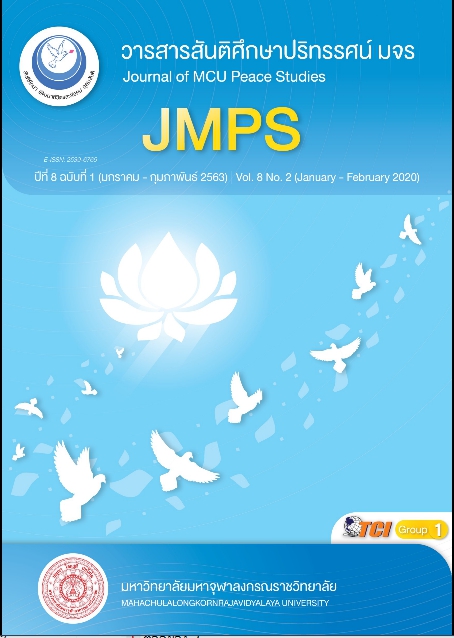บุพปัจจัยของความยั่งยืนของการท่องเที่ยวเมืองรอง
Main Article Content
บทคัดย่อ
การวิจัยครั้งนี้มีวัตถุประสงค์ เพื่อศึกษาอิทธิพลของสภาพแวดล้อมของสถานที่ท่องเที่ยว สิ่งอำนวยความสะดวกของสถานที่ท่องเที่ยว ภาพลักษณ์ของสถานที่ท่องเที่ยว และความพึงพอใจของนักท่องเที่ยว ที่มีผลต่อความยั่งยืนของการท่องเที่ยวเมืองรอง การวิจัยนี้ใช้วิธีการวิจัยเชิงปริมาณ กลุ่มตัวอย่างคือ นักท่องเที่ยวชาวไทยที่เคยท่องเที่ยวเมืองรอง ได้แก่ จังหวัดบุรีรัมย์ จังหวัดราชบุรี จังหวัดสตูล จังหวัดลำปาง และจังหวัดจันทบุรี จำนวน 300 คน การกำหนดขนาดตัวอย่างโดยเกณฑ์ของไคลน์ คือ 20 เท่าของตัวแปรสังเกต ใช้วิธีการสุ่มตัวอย่างแบบหลายขั้นตอน เก็บข้อมูลด้วยแบบสอบถาม และวิเคราะห์ด้วยแบบจำลองสมการโครงสร้าง ผลการวิจัยพบว่า ภาพลักษณ์ของสถานที่ท่องเที่ยว มีอิทธิพลโดยรวมต่อความยั่งยืนของการท่องเที่ยวเมืองรอง มากที่สุด รองลงมา คือ สภาพแวดล้อมของสถานที่ท่องเที่ยว ความพึงพอใจของนักท่องเที่ยว และ สิ่งอำนวยความสะดวกของสถานที่ท่องเที่ยว ตามลำดับ ผลของการวิจัยนี้ สามารถใช้ประกอบการวางแผนยุทธศาสตร์การท่องเที่ยวของภาครัฐ และผู้ประกอบการในเมืองรอง ผลักดันให้สถานที่ท่องเที่ยวในพื้นที่เมืองรองกลายเป็นจุดหมายยอดนิยมของนักท่องเที่ยวทั้งชาวไทยและชาวต่างชาติ
Article Details
ทัศนะและความคิดเห็นที่ปรากฏในบทความในวารสาร ถือเป็นความรับผิดชอบของผู้เขียนบทความนั้น และไม่ถือเป็นทัศนะและความรับผิดชอบของกองบรรณาธิการ ยินยอมว่าบทความเป็นลิขสิทธิ์ของวารสาร
เอกสารอ้างอิง
Bagdare, S. (2016). A Conceptual Framework for Management of Tourism Experience. Imperial Journal of Interdisciplinary Research, 2(6), 718-722.
Chen, C. F. & Chen, F. S. (2010). Experience Quality, Perceived Value, Satisfaction and Behavioral Intentions For Heritage Tourists. Tourism Management, 31(1), 29-35.
Goeldner, C. R., Ritchie, J. R. B. & McIntosh, R. W. (2000). Tourism Components and Supply. Tourism: Principles, Practices, Philosophies, 362-393
Grappi, S. & Montanari, F. (2011). The Role of Social Identification and Hedonism in Affecting Tourist Re-Patronizing Behaviors: The Case of an Italian Festival. Tourism Management, 32(5), 1128-1140.
Kassean, H. & Gassita, R. (2013). Exploring Tourists Push and Pull Motivations to Visit Mauritius as a Tourist Destination. African Journal of Hospitality, Tourism and Leisure, 2(3), 1-13.
Kline, R. B. (2005). Principle and Practice of Structural Equation Modeling. New York: Guilford.
Lee, C. K., Lee, Y. K. & Lee, B. (2005). Korea’s Destination Image Formed by the 2002 World Cup. Annals of Tourism Research, 32(4), 839-858.
Loureiro, S. M. C. & González, F. J. M. (2008). The importance of quality, satisfaction, trust, and image in relation to rural tourist loyalty. Journal of Travel & Tourism Marketing, 25(2), 117-136.
Master Card Global Destination Cities Index. (2018). Big Cities, Big Business: Bangkok, London and Paris Lead the Way in Master Card’ S 2018 Global Destination Cities Index. Retrieved February 4, 2019, from https://newsroom.mastercard.com/
Ministry of Tourism and Sports. (2019). Summary of the Camp Situation Number of Visitors and Income from Visitors Jan - Dec 2018. Retrieved January 31, 2019 from https://www.mots.go.th/ more_news.php?cid=509&filename=index
Morrison, A. & Anderson, D. (2002). Destination branding. In Annual Meeting of the Missouri association of convention and Visitor Bureaus, 17.
Phillips, W. J., Wolfe, K., Hodur, N. & Leistritz, F. L. (2013). Tourist Word of Mouth and Revisit Intentions to Rural Tourism Destinations: A case of North Dakota, USA. International Journal of Tourism Research, 15(1), 93-104.
Prayag, G., Chen, N., Hosany, S. & Odeh, K. (2016). The cognitive-affective relationship of tourists to a heritage site: The case of Petra. TTRA Canada 2016 Conference. Retrieved March 25, 2016, from https://scholarworks.umass.edu/ttraca nada_2016_conference/25
Rajesh, R. (2013). Impact of Tourist Perceptions, Destination Image and Tourist Satisfaction on Destination Loyalty: A Conceptual Model. Pasos. Revista de Turismo y Patrimonio Cultural, 11(3), 67-78.
Ramkissoon, H., Uysal, M. & Brown, K. (2011). Relationship between Destination Image and Behavioral Intentions of Tourists to Consume Cultural Attractions. Journal of Hospitality Marketing & Management, 20(5), 575-595.
Sirisom, W. (2017). Sustainable Thai Tourism... Emphasizing Quality, not focus on Quantity. Retrieved March 23, 2019, from https://www.matichon.co.th/economy/news_1303118
Thai Rath Online. (2018). TAT Invites You to Experience the Charm of “Muang Rong”. Once Tried, Will Fascinate. Retrieved Febuary 26, 2018, from https://www.thairath.co.th/ content/1363765
Wanich, Y. (2019). 50th Thai Tiew Thai. Retrieved March 23, 2019, from https://www.thairath. co.th/news/business/1502300


